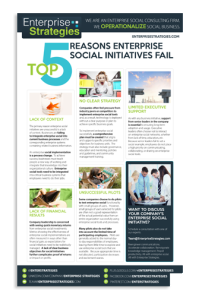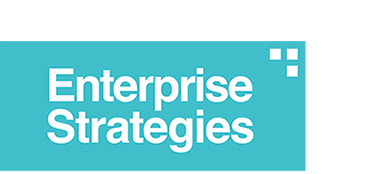
09 Oct Are Yammer, Chatter and others in Trouble?
It is no secret that I am huge proponent of, and believer in the power of, Enterprise Social Networks (ESNs). Being the Founder of a company that helps organizations implement and drive usage of various types of ESNs (e.g., Yammer, Chatter, etc.), I am also very careful to be technology neutral. We have to be — in terms of scale, we are a rounding error on the lunch budget of one of those company’s executives. All this said, I have been watching a situation develop over the last couple of years, and I think it is now appropriate to share it with our readers. I ask that you please view this post in the way that it was intended, as an observation from an Enterprise Social Network nerd who has been studying this space for the last 5 years. Here goes…
Background
Right about the time I left Oracle, a little more than 5 years ago, they were just starting to use a homegrown internal social network, named not so creatively Oracle Social Network (OSN). It was a Facebook-style internal collaboration platform, a pet project of one of the development teams, and while well-intentioned, a bit clunky. I did not think much of it.
Fast forward 5 years…
Oracle Social Network (Silently) Hits the Market
With the release of Oracle’s Version 7 Cloud Applications, Oracle started making OSN available to their customers. I was invited, by a good friend and former co-worker of mine, David Christopher, Director of EMEA Social Business Programs, to see a demo. What I saw was not the OSN of five years prior, but instead a fully functional, well-designed ESN, seamlessly integrated with some of Oracle’s cloud enterprise business applications (e.g., HCM, ERP, the best CRMs, etc.). In essence, while my company had been out preaching to others the importance of integrating internal social networks with critical business systems (and watching other software companies fail to do this), Oracle had been quietly developing exactly that. I knew immediately this was significant, but in fairness, it remained to be seen how Oracle would position this product. And, to be completely honest and transparent, I have been extremely critical of Oracle in the past. Here is where I think things currently stand and why, if done with attention and aggression, Oracle’s Social Network could eliminate the need for other internal social networks at Oracle Cloud clients.
Focusing Social on Real Business Processes (e.g., Solving the Problem of Context)
For the last 5 years we (Enterprise Strategies) have witnessed firsthand the importance of having your internal social network integrated with real business processes. Our encounters have ranged from the comical, such as when a new client informed us that the most commented, liked and shared post on their previous (before us) ESN was, “Does anyone have a good recipe for guacamole?” to the conclusive, such as when we implemented a new ESN at that same client and drove usage and adoption 10-fold in 6 months by tying it to their sales processes and data. Quite frankly, one of the main reasons that Enterprise Social Networks fail is Lack of Context.
 Free Download: Top 5 Reasons Enterprise Social Initiatives Fail
Free Download: Top 5 Reasons Enterprise Social Initiatives Fail
In this download, you will find the following information:
- The most common reasons enterprise social initiatives fail and what you can do to avoid them
- Enterprise social initiative best practices
- What we have learned from delivering several successful enterprise social initiatives at our clients
Oracle Social Network Solves the Problem of Context
To say that Oracle has “integrated” OSN with its cloud applications is actually a bit of a misnomer. I think it is more accurate to say that it is a built-in part of the cloud applications. In fact, using OSN as part of their cloud applications feels more like leveraging social features inside the application than being on a social network. Most notable are:
- The ability to post questions (and receive comments and answers) on the same screens that contain your company’s critical business information
- The ability to bring people from around your organization into business process and business data contextual discussions, present them with the information they need to contribute answers, and keep them informed as the discussions evolve all without requiring them to have a full access (licenses) for that application (e.g., CRM, ERP, HCM, etc.)
- The ability to annotate documents directly in business applications themselves, looking at the business data you need to see during this process (e.g., annotate a proposal you are reviewing for approval from within the CRM — where the contextual information you need is stored)
This is a powerful paradigm shift from ESNs focused on “being social” to application suites the allow you to seamlessly leverage the power of social to get business done.
If you could save your company between $1.62M and $10.8M annually (or use it elsewhere), would you?
Another feature in OSN’s favor is the price. Oracle gives it away for free. No, I can’t believe I just typed those words either, but they are true. If your organization currently uses of the social enabled Oracle Cloud version 7 applications (e.g., CRM, HCM, ERP, etc.) your entire company can use OSN for free. How does this compare to other ESNs?
The list price for Salesforce’s Chatter Plus enterprise social network, which integrates with a subset of the components of their CRM application, is $20 per user per month.
The list price for Microsoft’s Yammer’s standalone enterprise social network (standalone meaning it is not integrated with any business applications) is $3 per user per month.
In 2014, companies listed on the Forbes Global 2000 company list employed roughly 90 Million people. This equates to an average of approximately 45,000 employees at each company.
($20 x 45,000 employees) x 12 months = $10,800,000 annually
($3 x 45,000 employees) x 12 months = $1,620,000 annually
In an economy where pennies are being pinched, saving your company between $1.62M and $10.8M annually is, well, a no-brainer. Equally as exciting is having that money back in the budget to help pay for your current enterprise cloud business applications or even your move from on-premise to cloud.
So why am I just now hearing about OSN?
Well first off, let me assure you that you are in good company. Many of Oracle’s Cloud version 7 clients do not even know they have OSN. Why? Well, because it is free. More directly, no one at Oracle is getting paid to tell you that you have it or to sell it to you if you don’t. But what about Oracle’s (sometimes outspoken) management? Well, to be honest, for the life of me, I can not figure this one out. I attended Oracle’s OpenWorld this month and during Larry Ellison’s Sunday night keynote you would have passed out playing a drinking game recognizing every time he said the word “Salesforce.” Salesforce is currently (heavily) using Chatter to differentiate its CRM offering. Why Larry, Mark, Safra or their army of sales professionals do not start using OSN to (theoretically) redirect $10.8M in spend at even a subset of 2000 global companies is a bit of a mystery to me.
The Big Question: Will Oracle Capitalize or Miss the (America’s Cup) Boat
So there you have it. The stage is set. Oracle is currently losing the Enterprise Social Network battle, down by a score of (at least) 8 to 1. When faced with this scenario during the 2013 America’s Cup Race, Oracle Team USA’s Captain turned the question of, “Can Oracle win?” back to the audience, saying, “Maybe a better question would be what if we did? What would a comeback of these epic proportions look like?” The question for Oracle management is whether or not they care (or believe) as strongly as Jimmy Spithill. Just like we saw at the America’s Cup, if an Oracle team decides they want to do something, with their combined resources behind them, there are very few things in this world that can stop them.

